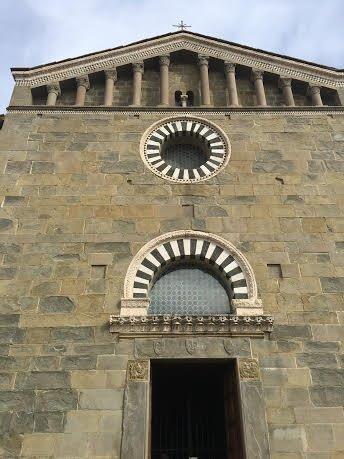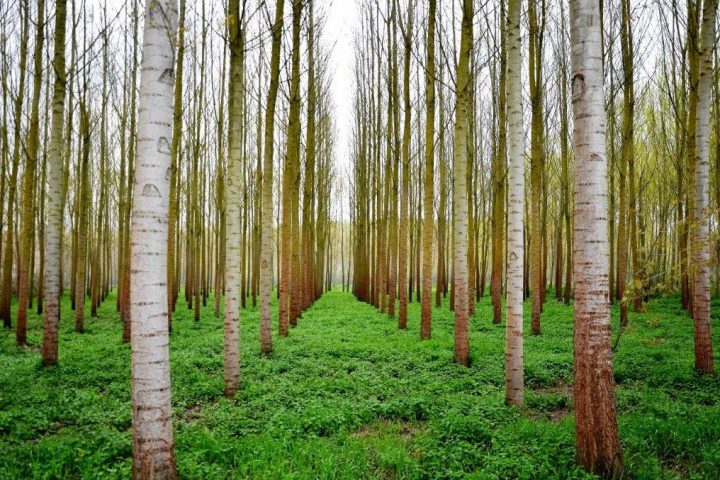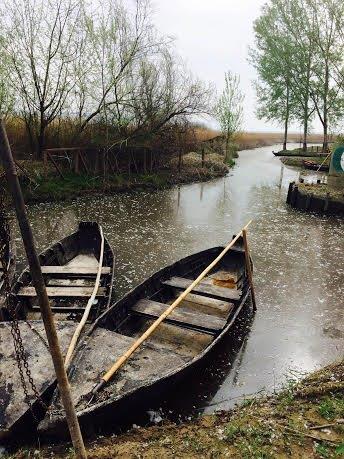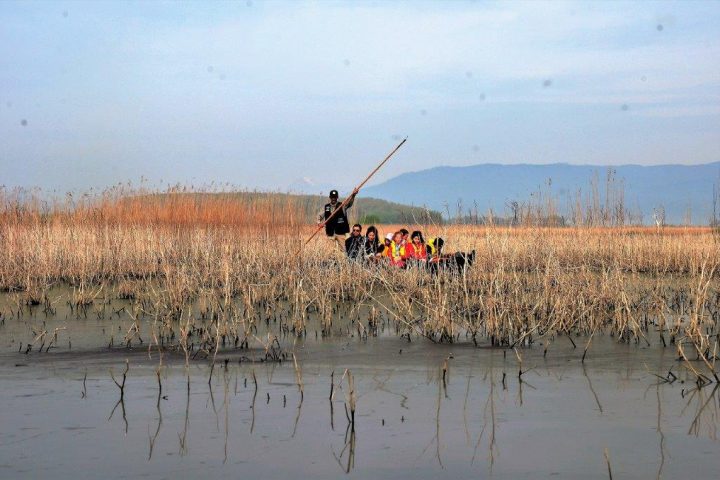Visitors to the Province of Pistoia are greeted with an enormous array of natural and cultural gems, many of which are largely undiscovered. From the beautiful rolling Tuscan hills lined with grapes vines and olive groves, producing well known oil and wine, to the ten medieval hill town villages above Pescia, to Fucecchio with its spectacular nature reserve. From the thermal waters of the spa towns Montecatini and Monsummano Terme, to the Villa and garden of Pinocchio and Leonardo’s home town of Vinci. There are hiking trails, museums, churches, glorious vistas, wonderful food and wine, and all within easy reach of Florence and Pisa.
The Fucecchio Marshes Nature Reserve, covers over 1,800 hectares and is recognised as the largest wetland in Europe. Known as the ‘Padule di Fucecchio’ there are observatories for birdwatching, walking tracks, bike trails, and a chance to explore these amazing waterways on a traditional “Barchino”, a flat bottom boat that glides ever so peacefully through the canals. This allows you the perfect opportunity to see a large variety of flora with rare aquatic plants along the banks and fauna which enjoy the humidity of this area. With over 200 different species of birds such as 1,500 pairs of herons, it’s the perfect time to visit, with migration and breeding seasons, there is lots of activity on the water.
There are educations centres such as ‘Dogana’ Customs House with state of the art education facilities to explore the history of this unique area. There are exhibition centres dedicated to the flora and fauna and demonstrating the use of the rushes to weave the baskets throughout history.
For a complete schedule of guided tours for 2016 call Centro R.D.P. Padule di Fucecchio Tel. 0573/84540 fucecchio@zoneumidetoscane.it/www.zoneumidetoscane.it/eventi/padeventi. My recommendation is a guided tour on a “barchino”.
San Quirico is one of the ten castle villages that have co-existed next to each other since the middle ages. Perched in the valley above the busy town of Pescia they each have their own unique history and qualities. Spectacular views from the San Quirico bell tower of this largely unexplored part of Pistoia. San Quirico had a thriving industry of bell making, that provided bells to hundreds of churches all over Italy. Weddings, funerals and general good news are all given the San Quirico bell treatment.
A short walk from San Quirico lies another hill town with the more famous Pieve in Castelvecchio. Famous due to its grandeur and construction solely from the local Serna Stone. A stone so hard that Michelangelo sent his apprentices here to practise their chiselling skills before they moved on to the more expensive Marble. The craftsmen that carved the decorations and motifs into the stone were often from Castelvecchio and so it’s a village that proudly celebrates its artists and culture.
The Rosary Room, in the town centre, has entire walls and ceiling covered with frescoes of various popular bible parables. For centuries the good parishioners of Castelvecchio would come here with their beads and perform the Rosary.
A visit to a third Castle town, Sorana, home of the famous Sorana Bean. They are a highly productive pole bean which have been the favourite fancy of bean eaters in Tuscany. When Verdi was living nearby in Montecatini he would often come to Sorana just to have a delicious plate of the magic little bean. Don’t miss the chance to experience this favoured bean at one of the local trattoria’s.
Taking another direction from Pescia is the hilltown of Uzzano. A visit to the Castle at Uzzano which is simple looking structure positioned on the mountain edge was very strategic in times of War. It was built to provide a visual line of communication to wine town of Montecarlo. It was like an early warning system to give notice if the armies of Lucca or Florence were on the move. Today it is an area filled with beautiful old villas with olive groves all along the mountain side. Puccini completed his most popular opera La Boheme while living in a Villa in Uzzano.

Down the hill to the wonderfully restored Buggiano Castle. At present there is a wonderful Exhibition of Photography from a turn of the 20th Century Photographer from Pescia called Alfredo Lumachi. It’s a wonderful look at all the villages from the early 1900’s. There are no cars just beautiful stone buildings that have lasted for centuries and provided wonderful meeting and work places for the people of the mountains.
Vinci is a picturesque medieval town, overlooking the olive groves and vineyards of the Montalbano region below. It is best known as the hometown of Italy’s most famous artist and inventor, Leonardo da Vinci. Leonardo’s genius included paintings, drawings, blueprints, machines and many inventions.
A visit to the Museo Leonardiano, the museum of Leonardo da Vinci, is a must. The museum is divided into two parts one in the 12th century Castle of Count Guidi and houses one of the largest collections in the world of Leonardo’s models, reconstructed from his drawings. With over 80 models and drawings including textile manufacturing machines, military machines and machines for travel. The exhibition also uses videos and 3D digital animations to enhance the experience.
Enjoy a walk around the small historic centre where you can visit the Church of Santa Croce where Leonardo is thought to have been baptised. There are restaurants, bars, and a tourist information.
Vinci is situated 35 kilometres from Florence and can be accessed by Train to Empoli and Bus to Vinci. Opening hours for the Museum can be found on http://www.museoleonardiano.it
Biblioteca Capitolare, Pescia

A wonderful, totally unexpected addition is the well preserved library next to the Duomo in Pescia. A 500-year private collection keeps this library generally closed to the general public.
The library originated after Cardinal Romualdo Cecchi bequeathed all his books in 1648 to the Cathedral. Then in 1666 Alexander VII publically gave recognition to the library which then led to more bequeaths throughout the centuries. With approximately 560 priceless editions there are sculptures and paintings from the fifteenth and sixteenth centuries, and period furniture.
The library has a wonderful arched ceiling covered in frescoes presenting an awe inspiring vision on entering. For the history lover this is a rare find.
Monsummano Terme has rich history which includes the only red marble quarry in Italy which can be seen in many of the great buildings of Florence. It was the centre of quality leather shoe manufacture and is the ideal gateway to the Padule of Fucecchio. While the marble quarry has ceased operation Gucci and Ferragamo still make many of their shoes here. The Medici’s have had a long history with the town and they built the church in the main square where its holy waters were capable of creating many miracles. So far they have recorded over ten official miracles approved by the Pope. The wonderful museum ‘Museo di Territorio’ offers an entry point to the rich traditions and social customs of the area.
Villa Renatico Martini, the home of writer, publisher and politician was recently acquired by the Commune and is now the centre for Contemporary Art Exhibitions in the Pistoia region. The MAC,N facility changes exhibitions frequently and its gardens are a wonderful place to visit.
Monsummano Alto is now a favourite spot for trekkers who can cope with the three kilometre uphill climb to the top. Once there walkers are rewarded with a stunning panoramic view of the entire Montalbano region. For those wishing to eat, there is an award winning restaurant where every table enjoys the best views of the house.
Pieve a Nievole “Poggia alla Guardia”
Poggia alla Guardia is a guided walk through the municipality of Pieve a Nievole through a naturally hilly natural protected environment.
Unique features within this area are the limestone outcrops, the Chiroptera (bats) who make their home in winter in the caves, and now in Spring, the beautiful wild orchids and other native flora are in abundance.
Well signposted the walk is approximately 5kms in duration with requires just a general level of fitness. The route heads to the Hill of Montecatini Alto through an avenue of traditional Cypress pines. Through bushland with filtered views of hilltop villages, olive groves, vines growing on terraces, small private gardens with fruit orchards in blossom. It is a relaxing walk under the guidance of a qualified expert on flora and fauna who showcases native vegetation and identifies the symbiosis between the wild orchids and the local mushrooms and bees. There is plenty of tree cover but water and a hat are suggested and good walking shoes as the pathways are in some places rocky and hilly.
On the way down you pass the famous “Dante Bridge”. Dante waited on this bridge to know the outcome of a battle between the two opposing factions of Guelphs and Ghibellines in Dante’s Inferno. As you head back down the hill you are greeted with lovely lush green fields, a very pleasant afternoon spent in nature.
With so much culture, history and nature on offer, it is easy to see why Pistoia was awarded the title of Italian Capital for Culture for 2017. This is just a sample of what awaits visitors to the Pistoia region. For information on guided walks and accommodation contact me on www.carolyntravers.com














Comments